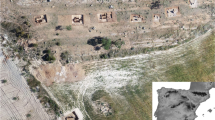Abstract
The use of science-based dating methods in historic preservation contexts represents a specialized use of dating method technologies more broadly employed in prehistoric archaeological studies. This discussion focuses attention on the applications of the radiocarbon, dendrochronology, obsidian hydration, and archaeomagnetic dating in historic preservation. The employment of various analytical and technical approaches — of which chronometric resolution is only one aspect — in elucidating and extending descriptive observations is advancing more broadly-based and insightful understandings of the elements of the cultural patrimony of our nation.
Similar content being viewed by others
References
Aitken, M.J., Science-based Dating in Archaeology (London: Longman, 1989).
Bannister, B., “Dendrochronology”, in D. Brothwell and E. Higgs (eds.), Science in Archaeology, 2nd edition (London: Thames and Hudson, 1969), pp. 191-205.
Beer, J. and others, “The contribution of the Swiss lake-dwellings to the calibration of radiocarbon dates”, in R. Berger and H.E. Suess (eds.), Radiocarbon Dating (Los Angeles: University of California Press, 1979), pp. 566-590.
Damon, P.E. and others, “Radiocarbon dating of the Shroud of Turin”, Nature 337 (1989), 611-615.
Dean, J.S., “Dendrochronology”, in R.E. Taylor and M.J. Aitken (eds.), Chronometric Dating in Archaeology (New York: Plenum Press, 1997), pp. 31-64.
Eighmy, J.L. and R.S. Sternberg, Archaeomagnetic Dating (Tucson: The University of Arizona Press, 1990).
Ferguson, C.W. and others, “Determination of the age of Swiss lake dwellings as an example of dendrochronologically-calibrated radiocarbon dating”, Zeitschrift fur Naturforschung 21A (1966), pp. 1173-1177.
Friedman, I., F.W. Trembour and R.E. Hughes, “Obsidian hydration dating”, in R.E. Taylor and M.J. Aitken (eds.), Chronometric Dating in Archaeology (New York: Plenum Press, 1997), pp. 297-322.
Göksu, H.Y., M. Oberhofer and D. Regulla, Scientific Dating Methods (Dordrecht: Gluwer Academic Publishers, 1991).
deJong, A.F.M. and W.G. Mook, “Medium-term atmospheric 14C variations”, Radiocarbon 22 (1980), pp. 267-272.
Klein, J., J.C. Lerman, P.E. Damon and E.K. Ralph, “Calibration of radiocarbon dates: Tables based on the consensus data of the workshop on calibrating the radiocarbon time scale”, Radiocarbon 24 (1982), 103-150.
Kojo, Y., R.M. Kalin and A. Long, “High-precision 'wiggle-matching' in radiocarbon dating”, Journal of Archaeological Science, (1994, in press).
Kruse, H.H. and others, “Computer-matched radiocarbon dates of floating tree-ring series”, Radiocarbon 22 (1980), pp. 260-266.
Linick, T.W., P.E. Damon, D.J. Donahue and A.J.T. Jull, “Accelerator mass spectrometry: the new revolution in radiocarbon dating”, Quaternary International 1 (1989), pp. 1-6.
Michels, J.W., “Obsidian hydration dating”, Endeavour 10 (1986), pp. 97-100.
Pearson, G.W. and others, “Precise calendrical dating of known growth-period samples using a 'curve fitting' technique”, Radiocarbon 28 (1986), 292-299.
Snethkamp, P.E., R.E. Taylor, R. Maddin, L.A. Payen and P.J. Slota Jr., “The origin of the Goleta Cannons: Inferences of age based on various lines of evidence”, Historical Archaeology 24 (1990), 82-91.
Southon, J.R. and others, “Progress in AMS measurements at the LLNL spectrometer”, Radiocarbon 34 (1992), 473-477.
Sternberg, R., “The geophysical basis of archaeomagnetic dating”, in J.L. Eighmy and R.S. Sternberg (eds.), Archaeomagnetic Dating (Tuscon: University of Arizona Press, 1990), pp. 5-28.
Sternberg, R.S., “Archaeomagnetic dating”, in R.E. Taylor and M.J. Aitken (eds.), Chronometric Dating in Archaeology (New York: Plenum Press, 1997), pp. 323-356.
Stevenson, C.M., J. Carpenter and B.E. Scheetz, “Obsidian dating: recent advances in the experimental determination and application of hydration rates”, Archaeometry 31 (1989), pp. 193-206.
Stuiver, M. and R. Kra, “Calibration issue”, Radiocarbon 28 (1986), pp. 805-1030.
Stuiver, M., “A high-precision calibration of the AD radiocarbon time scale”, Radiocarbon 24 (1982), pp. 1-26.
Stuiver, M. (ed.), “Calibration 1993”, Radiocarbon 35 (1993), pp. 1-244.
Suess, H. and C. Strahm, “The neolithic of Auveneir, Switzerland”, Antiquity 44 (1970), pp. 91-99.
Taylor, R.E., Radiocarbon Dating An Archaeological Perspective (Orlando: Academic Press, 1987).
Taylor, R.E., “Radioisotope dating by accelerator mass spectrometry: archaeological and paleo-anthropological perspectives”, in H.Y. Göksu, M. Oberhofer and D. Regulla (eds.), Scientific Dating Methods (Dordrecht: Gluwer Academic Publishers, 1991), pp. 37-54.
Taylor, R.E., “Radiocarbon dating”, in R.E. Taylor and M.J. Aitken (eds.), Chronometric Dating in Archaeology (New York: Plenum Press, 1997), pp. 65-96.
Taylor, R.E., A. Long and R.S. Kra (eds.), Radiocarbon After Four Decades An Interdisciplinary Perspective (New York: Springer Verlag, 1992).
Taylor, R.E., L.A. Payen and P.J. Slota Jr., “The age of the Calaveras Skull: Dating the 'Piltdown Man' of the New World”, American Antiquity 57 (1992), pp. 269-275.
Taylor, R.E., J.M. Suchey, L.A. Payen, and P.J. Slota Jr., “The use of radiocarbon (14C) to identify human skeletal materials of forensic science interest”, Journal of Foresnsic Sciences 34 (1989), pp. 1196-1205.
Taylor, R.E., M. Stuiver and P.J. Reimer, “Development and extension of the calibration of the radiocarbon time scale: Archaeological applications”, Quaternary Sciuence Reviews (Quaternary Geochronology) 15 (1996), 655-668.
U.S. Congress, Office of Technology Assessment, Technologies for Prehistoric and Historic Preservation, OTA-E-319 (Washington, D.C.: U.S. Government Printing Office, 1986).
Wolfli, W., “Advances in accelerator mass spectrometry”, in N.E. Gove, A.E. Litehrland and D. Elmore (ed.), Accelerator Mass Spectrometry (Amsterdam: North-Holland Physics Publishing, 1987), pp. 1-13.
Author information
Authors and Affiliations
Rights and permissions
About this article
Cite this article
Taylor, R.E. Science-Based Dating Methods in Historic Preservation. Archives and Museum Informatics 13, 227–247 (1999). https://doi.org/10.1023/A:1012419025537
Issue Date:
DOI: https://doi.org/10.1023/A:1012419025537




